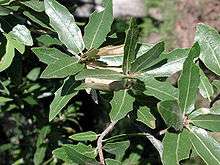Quercus emoryi
Quercus emoryi, the Emory oak, is a species of oak common in Arizona (including inside Saguaro National Park), New Mexico and western Texas (including inside Big Bend National Park), United States, and northern Mexico (Sonora, Chihuahua, Coahuila (including Parque Nacional Maderas del Carmen), Durango, Nuevo León, and San Luis Potosí).[3][4] It typically grows in dry hills at moderate altitudes.
| Emory oak | |
|---|---|
.jpg) | |
| Scientific classification | |
| Kingdom: | Plantae |
| Clade: | Tracheophytes |
| Clade: | Angiosperms |
| Clade: | Eudicots |
| Clade: | Rosids |
| Order: | Fagales |
| Family: | Fagaceae |
| Genus: | Quercus |
| Subgenus: | Quercus subg. Quercus |
| Section: | Quercus sect. Lobatae |
| Species: | Q. emoryi |
| Binomial name | |
| Quercus emoryi | |
 | |
| Natural range of Quercus emoryi | |
| Synonyms[2] | |
| |
Quercus emoryi is an evergreen tree in the red oak group, retaining its leaves through the winter until the new leaves are produced in spring, and is a large shrub or small tree from 5–17 meters (16–56 ft) tall. The leaves are 3–6 cm (1–2.5 in) long, entire or wavy-toothed, leathery, dark green above, paler below. The acorns are 1.5–2 cm (0.59–0.79 in) long, blackish-brown, and mature in 6–8 months from pollination; the kernel is sweet, and is an important food for certain mammals.[5]

The tree is named after the United States Army surveyor, Lieutenant William Hemsley Emory, who surveyed the area of west Texas where it was discovered in 1846.
Ecology and uses
The acorn is sweet and an important food for livestock, deer, squirrels, the Gila chipmunk, and birds such as quail and wild turkeys.[5][6][7] Deer and livestock also browse the foliage.[8]
Native Americans, especially the Apaches, ate the sweet acorns; these were ground into meal.[7]
References
- Wenzell, K. & Kenny, L. (2017). "Quercus georgiana". IUCN Red List of Threatened Species. 2017: e.T34011A2840268.
- "Quercus emoryi Torr.". World Checklist of Selected Plant Families (WCSP). Royal Botanic Gardens, Kew – via The Plant List.
- SEINet, Southwestern Biodiversity, Arizona chapter
- "Quercus emoryi". County-level distribution map from the North American Plant Atlas (NAPA). Biota of North America Program (BONAP). 2014.
- Nixon, Kevin C. (1997). "Quercus emoryi". In Flora of North America Editorial Committee (ed.). Flora of North America North of Mexico (FNA). 3. New York and Oxford – via eFloras.org, Missouri Botanical Garden, St. Louis, MO & Harvard University Herbaria, Cambridge, MA.
- Little, Elbert L. (1994) [1980]. The Audubon Society Field Guide to North American Trees: Western Region (Chanticleer Press ed.). Knopf. p. 397. ISBN 0394507614.
- Peattie, Donald Culross (1953). A Natural History of Western Trees. New York: Bonanza Books. pp. 443–44.
- Whitney, Stephen (1985). Western Forests (The Audubon Society Nature Guides). New York: Knopf. p. 383. ISBN 0-394-73127-1.
External links
| Wikimedia Commons has media related to Quercus emoryi. |
